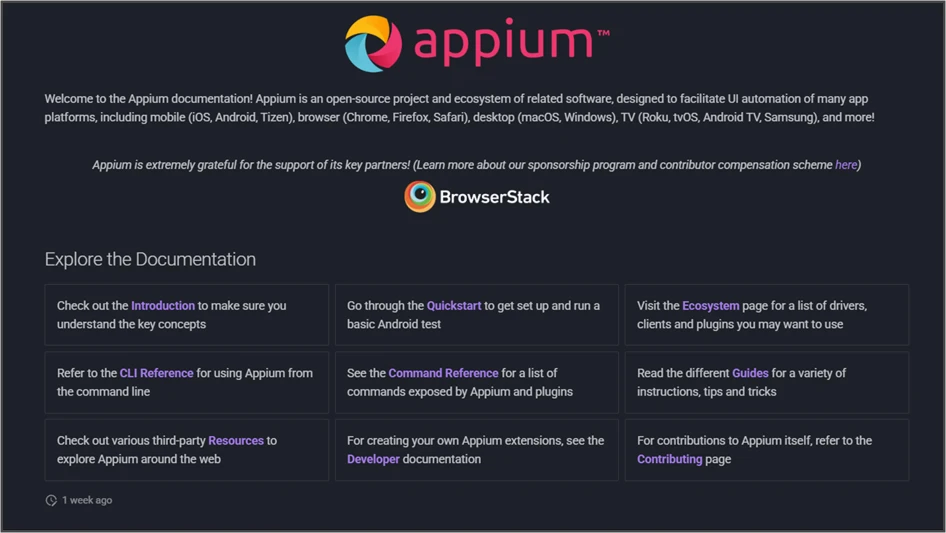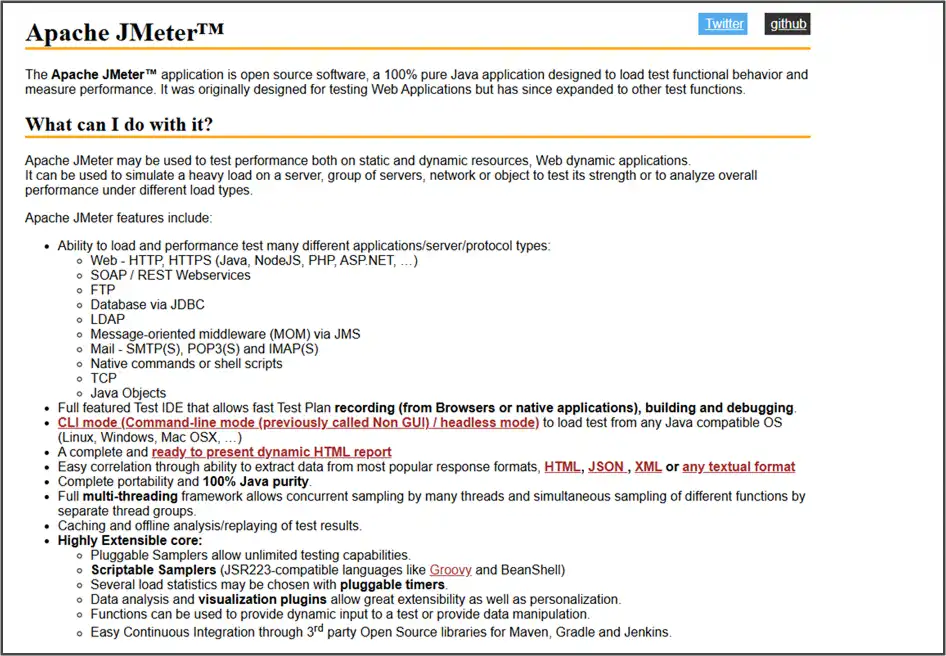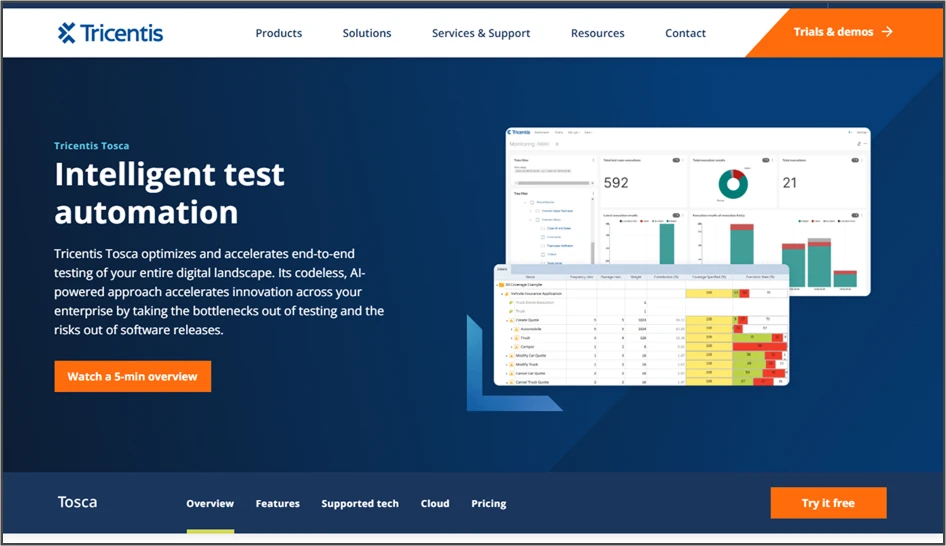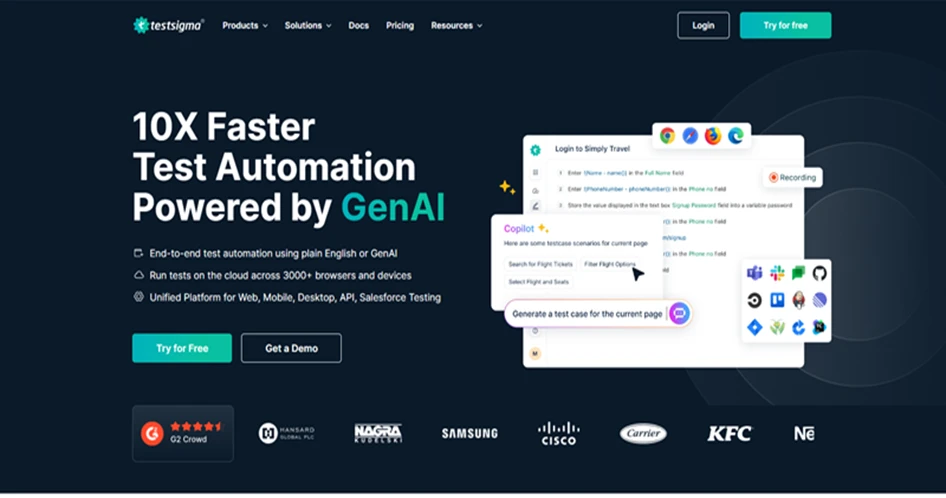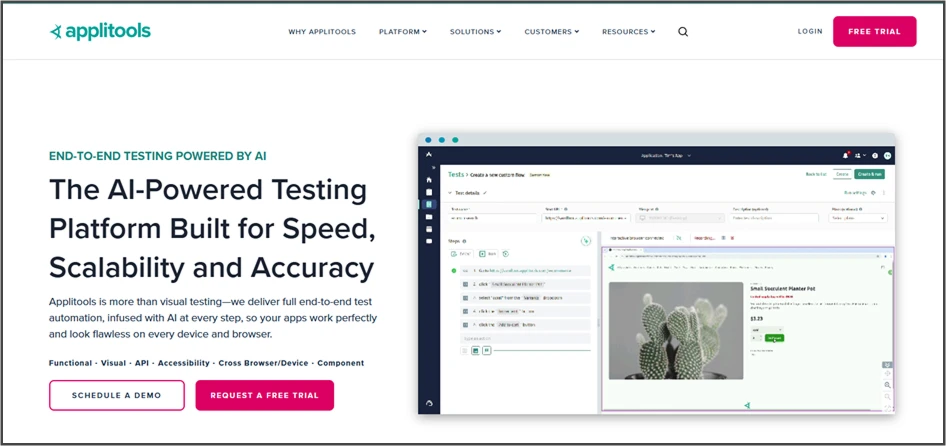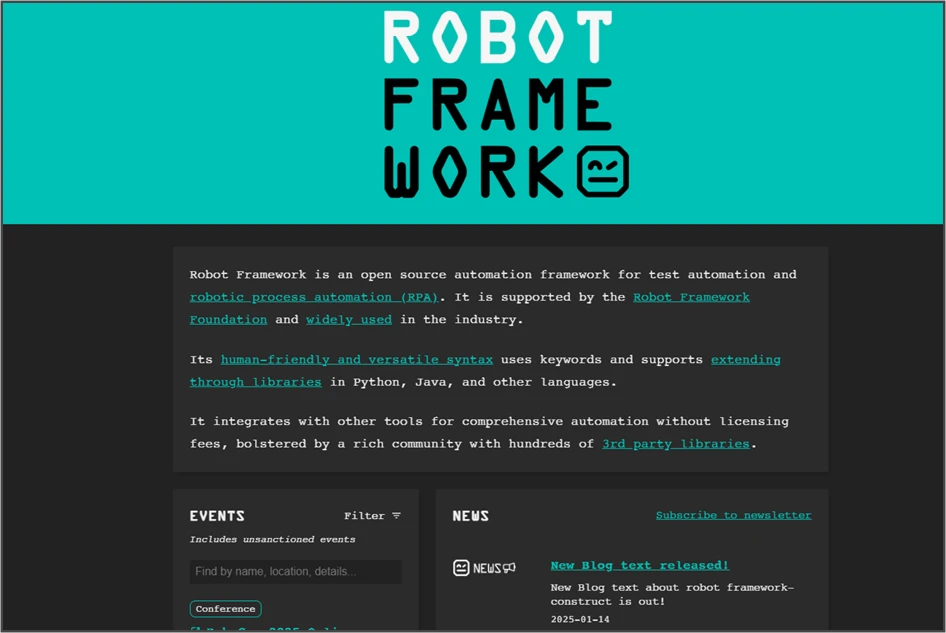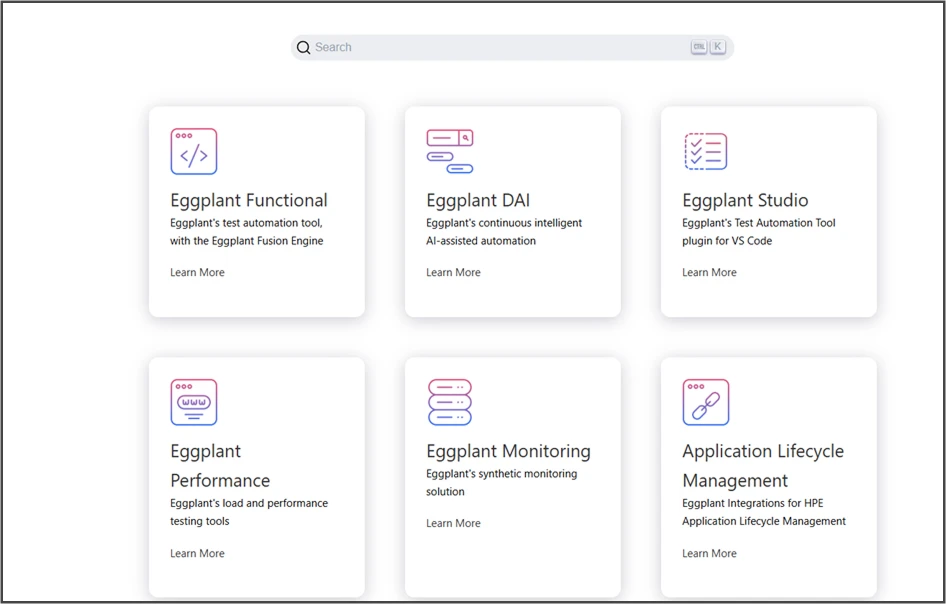Delivering high-quality applications is no longer optional but has become the need of the hour. As software becomes increasingly complex and user expectations continue to rise, the role of quality assurance (QA) testing has never been more critical. Developers need tools that can quickly detect bugs, ensure functionality, and streamline workflows. In this blog, we will explore the top QA testing tools for 2025 that are driving the future of software quality assurance. Read along to find out.
Why QA Testing Tools Are More Important Than Ever in 2025
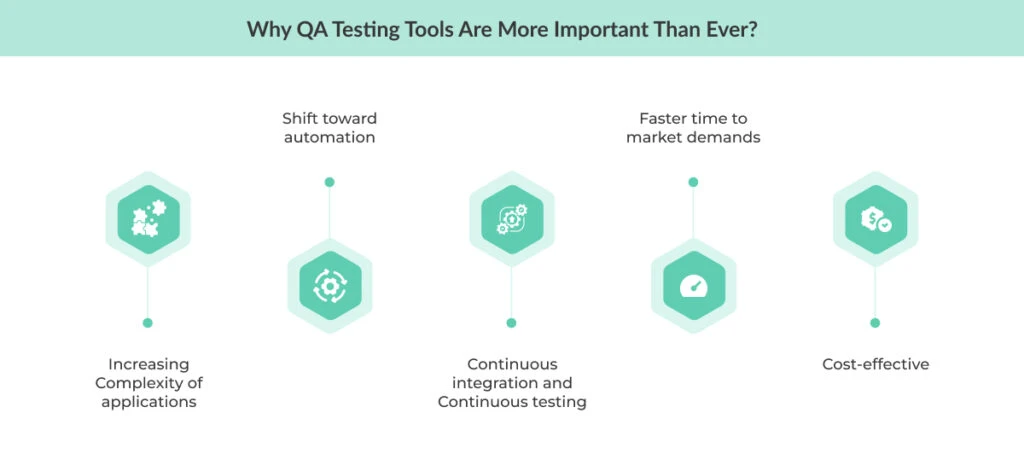
The complexity of modern applications continues to increase, which in turn is raising the demand for sophisticated, efficient, and reliable QA testing tools. Let’s explore why QA testing is more critical than ever and how these tools are evolving to keep up with the demands of the industry.
Increasing Complexity of Applications
Applications today are far more intricate than they were a few years ago. In 2025, we’re dealing with multi-platform environments, intricate APIs, and user interactions that span various devices and technologies. Whether it’s a mobile app powered by complex backend services or a web app that offers a rich user interface, the complexity of these systems calls for thorough testing.
Consider a modern mobile app. It needs to function across both iOS and Android, integrate with cloud-based services, and perform flawlessly even under heavy traffic. In addition to that, there is a need for APIs that interact with other systems, and it becomes clear that manual testing alone can’t keep up with the pace and depth of modern development. That’s where QA testing tools come into play—they help ensure that all these moving parts work harmoniously so you can deliver a seamless user experience.
Shift Toward Automation
One of the most significant trends driving the evolution of QA testing is the shift from manual to automated testing. This shift isn’t just a matter of preference; it’s a necessity in today’s fast-paced development cycles. Automation has become essential because it enables teams to test faster, more efficiently, and more accurately than ever before.
Automated testing eliminates the risk of human error, a key factor in ensuring that tests are thorough and repeatable. Additionally, automation offers comprehensive test coverage, allowing us to run tests across multiple browsers, devices, and environments. It also empowers developers to catch issues earlier in the development process, reducing the risk of defects slipping through to production.
In 2025, QA tools that support automation are indispensable, saving time, boosting efficiency, and ensuring quality at every stage of the development lifecycle.
Continuous Integration and Continuous Testing
With the rise of agile methodologies, continuous integration (CI) and continuous delivery (CD) pipelines have become the norm. As part of this workflow, automated QA testing tools need to integrate seamlessly into CI/CD systems. This allows tests to run automatically whenever new code is pushed to the repository, ensuring that developers get immediate feedback on their changes.
By automating testing within the CI/CD pipeline, we can catch bugs and issues early, making it easier for teams to fix them before they snowball into larger problems. This continuous testing model allows us to deploy updates more frequently, with greater confidence that new features won’t introduce regressions.
The role of QA testing tools in CI/CD pipelines is crucial for maintaining speed without sacrificing quality.
Faster Time-to-Market Demands
In today’s business environment, companies face immense pressure to release new features and updates quickly. The demand for faster time-to-market has never been more urgent, and QA testing plays a crucial role in meeting this demand. As businesses strive to stay competitive, they need tools that can provide reliable, instant feedback.
QA testing tools help speed up the release process by identifying potential issues early on, allowing teams to focus on critical bugs instead of spending time on manual testing. With automated tests, the entire software testing cycle can be completed more rapidly, ensuring that teams can release high-quality products faster without compromising on user experience.
Cost-Efficiency
Finally, QA tools are key to reducing long-term costs. By identifying defects early in the development cycle, these tools help prevent expensive post-release fixes. Testing early and often saves time and money by addressing issues before they escalate into larger, more costly problems.
Whether it’s preventing customer complaints, reducing downtime, or ensuring your team isn’t bogged down by extensive debugging in later stages of development, QA tools enable businesses to keep costs in check while maintaining high-quality standards.
What Makes a Good QA Testing Tool in 2025?

When it comes to choosing the right QA testing tool, the landscape in 2025 has evolved. With increasingly complex applications, rapid development cycles, and higher expectations for quality, your QA tools need to keep pace. So, what makes a testing tool truly stand out in this new era? Let’s explore the key aspects that define a good QA testing tool today.
Compatibility Across Platforms and Devices
In 2025, software applications are no longer confined to a single platform or device. They need to work seamlessly across web, mobile, desktop, and even IoT devices. As a result, a good QA testing tool must support testing across various platforms and environments. Whether you’re working with web browsers, native mobile apps, or hybrid systems, the tool should ensure your application behaves consistently across all devices, browsers, and OS versions.
A lack of cross-platform support can leave gaps in your testing coverage, potentially resulting in issues that only surface after release. So, it’s crucial to choose tools that provide broad compatibility to ensure your app delivers a flawless experience across the board.
Automation Features
Automation is at the heart of modern QA testing, and it’s become more important than ever. With the demand for faster releases and higher-quality software, a good testing tool must offer robust automation capabilities. Automation allows you to speed up testing cycles, run comprehensive regression tests, and reduce human error—all of which contribute to more reliable and faster releases.
But it’s not just about running tests automatically; it’s about how well the tool supports complex automated test cases. You need to look for tools that can handle functional and non-functional testing, provide easy-to-write scripts, and have UI and API testing capabilities. The more robust the automation features, the more streamlined your testing process will be.
Integration with CI/CD Pipelines
The reality of software development in 2025 is continuous integration (CI) and continuous delivery (CD). For QA testing tools to be truly effective, they must integrate seamlessly with CI/CD pipelines. This integration allows tests to be automatically triggered every time a change is made to the codebase, ensuring that feedback is immediate and that any issues are caught early.
Having your testing tools linked directly with CI/CD systems accelerates the development cycle, fosters collaboration between developers and testers, and ensures that every part of the application is continuously verified for quality without slowing down the process.
Ease of Use and User Interface
While functionality is essential, the ease of use of a QA testing tool cannot be overlooked. In 2025, many teams are adopting agile and DevOps practices, and tools need to cater to both developers and testers with varying levels of technical expertise. A clean, intuitive user interface (UI) is crucial to ensure your team can quickly adopt and effectively use the tool without a steep learning curve.
The best tools offer a user-friendly interface that streamlines test creation, execution, and management. Look for tools that allow testers to easily interact with the system and review test results without requiring deep programming knowledge.
Reporting and Analytics
Data-driven insights are invaluable when it comes to improving the quality of your application. A good QA testing tool should provide comprehensive reporting and analytics features, helping you track test progress, identify bottlenecks, and pinpoint areas of improvement. Detailed reporting allows your team to make informed decisions about the next steps and ensure that critical issues are addressed.
A well-designed reporting system should allow for real-time visibility into test results, trends over time, and clear breakdowns of pass/fail rates. Additionally, some tools even provide automated suggestions based on the test results, helping you understand the cause of failures and improve test efficiency.
Support for Agile and DevOps Methodologies
Agile and DevOps practices dominate the modern development landscape, and your QA testing tool must support these methodologies. Agile promotes flexibility and iterative development, while DevOps focuses on collaboration between development and operations teams for continuous delivery. A good QA tool should be designed to fit into these frameworks by allowing teams to work faster, collaborate more efficiently, and deliver features in smaller, more frequent releases.
Look for tools that support continuous testing, quick feedback loops, and seamless collaboration between cross-functional teams. The right tool will not only facilitate testing but also align with your overall development approach, enhancing productivity and ensuring quality at every stage of the process.
Best QA Testing Tools for 2025
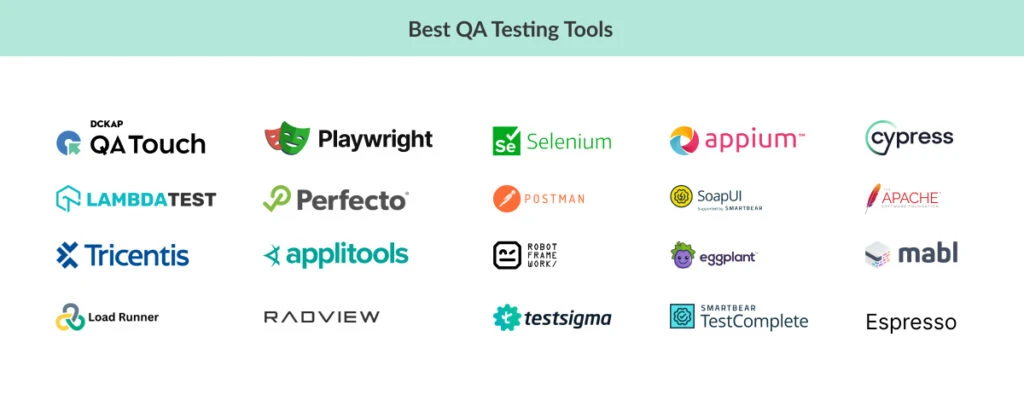
Whether you’re focusing on web, mobile, or API applications, the tools vary in their features, integrations, and pricing. Some tools excel in automated testing, while others specialize in manual testing or API testing. Here, have a look:
Selenium
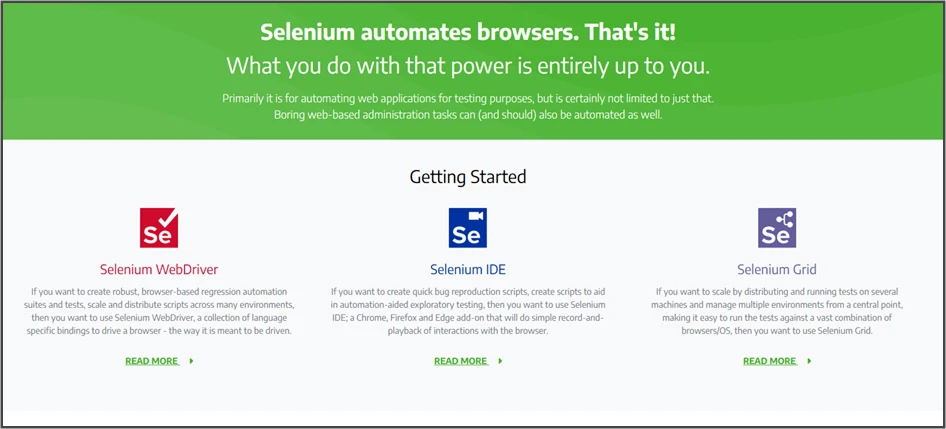
Selenium is a free, open-source tool used for automating web application testing. It works with multiple programming languages like Java, Python, and C#, and supports different web browsers. Selenium is ideal for teams that need full control over their test automation.
Ideal For:
- Teams with programming experience who want to customize their test automation
- Testing web applications with complex user interactions
Pros:
- Supports multiple programming languages and browsers
- Free and open-source
- Large community for support
Cons:
- Steep learning curve for beginners
- Requires programming knowledge
Pricing:
- Free (open-source)
Appium
Appium is an open-source tool that allows you to run the same test scripts on both Android and iOS devices, making it ideal for mobile testing projects that require cross-platform support. It is widely used for automating mobile application testing, enabling teams to maintain a single test suite for both platforms.
Ideal For:
- Teams that need cross-platform mobile test automation (iOS and Android).
- Developers and testers who are familiar with multiple programming languages and want flexibility in their test scripts.
Pros:
- Supports both Android and iOS with a single test script.
- Test scripts can be written in Java, Python, JavaScript, and others.
- No licensing fees, making it a cost-effective solution.
Cons:
- Test execution can be slower compared to some commercial tools.
- May encounter difficulties when dealing with intricate mobile UI elements.
Pricing:
- Free (open-source)
Playwright
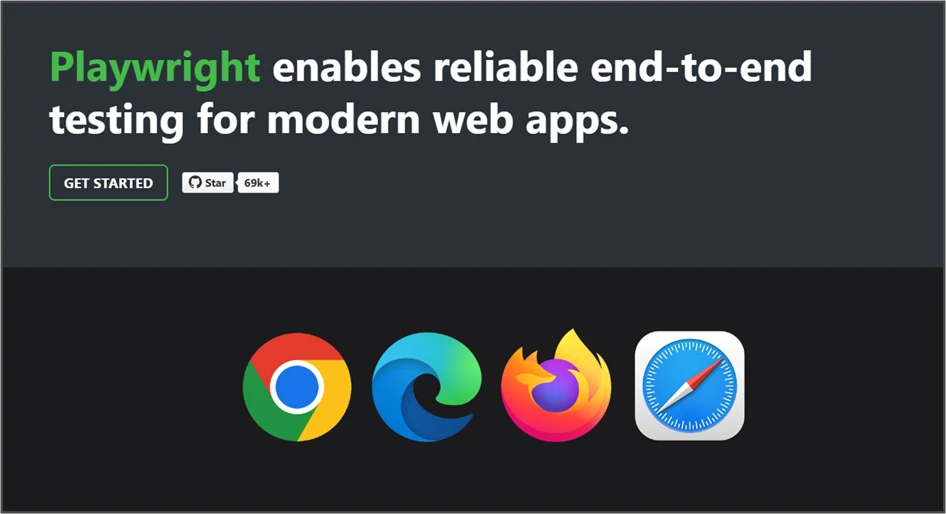
Playwright is a robust, open-source end-to-end testing framework that supports modern web applications. It provides cross-browser testing capabilities and is known for its speed and reliability. Playwright can automate interactions with web pages and handle modern web app features such as single-page applications (SPAs).
Ideal For:
- Teams working with modern web applications that need comprehensive testing solutions.
- Projects require cross-browser testing to ensure compatibility across different browsers.
Pros:
- Supports Chrome, Firefox, and WebKit (Safari).
- Can run tests quickly using headless browsers.
- Great for handling dynamic and interactive web applications.
Cons:
- Compared to tools like Appium, Playwright is focused more on the web and lacks deep mobile testing features.
- Requires some time to learn, especially for those new to end-to-end testing frameworks.
Pricing:
- Free (open-source)
QA Touch
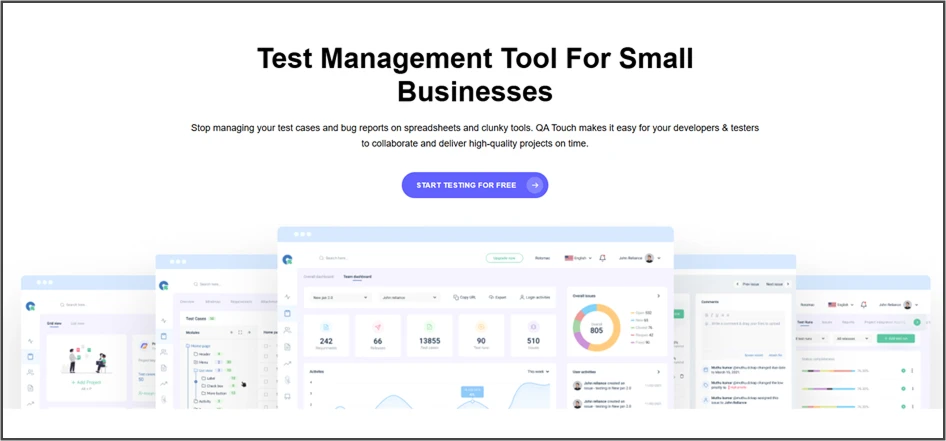
QA Touch is a test management platform that focuses on delivering a user-friendly experience while offering powerful customization and integration options. Its simplicity makes it ideal for teams that need a straightforward tool to manage their quality assurance processes, while its flexibility allows it to be tailored to meet the unique needs of various projects.
QA Touch stands out by providing seamless integration with an array of popular development tools, making it a versatile choice for teams looking to optimize their testing workflows and improve product quality.
Ideal For:
- Agile teams looking for an intuitive and easy-to-use test management platform that integrates well with agile workflows.
- Companies seeking smooth integration with existing Continuous Integration/Continuous Deployment (CI/CD) pipelines to streamline their testing processes and improve automation efficiency.
- Teams require simple bug tracking and test execution, whether for manual or automated tests, to ensure thorough quality checks and faster release cycles.
Pros:
- Intuitive and user-friendly interface: QA Touch boasts a clean, easy-to-navigate interface that minimizes the learning curve, allowing teams to quickly get up to speed with the platform.
- Strong integration capabilities: It integrates seamlessly with leading CI/CD tools like Jenkins, GitHub, and Bitbucket, enabling teams to automate tests and synchronize results with development workflows.
- Advanced reporting and analytics: The platform offers robust reporting tools that provide deep insights into test results, helping teams identify trends, monitor progress, and pinpoint areas for improvement.
- Supports both manual and automated testing: Whether you’re executing test cases manually or running automated scripts, QA Touch supports both methods, providing flexibility in testing strategies.
Pricing:
- Free version available: Free trial available
- Paid plans start at $49/month for 10 users, providing access to additional advanced features like unlimited integrations, priority support, and more comprehensive reporting and analytics tools.
Espresso
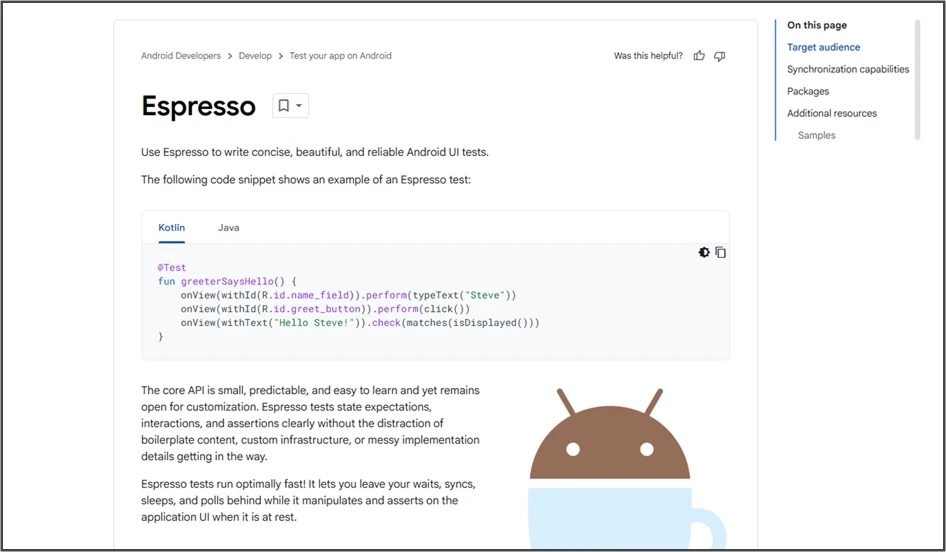
Espresso is a testing framework developed by Google for Android applications. It is designed specifically for UI testing, ensuring that Android apps function as expected in terms of user interaction and responsiveness. Espresso is tightly integrated with Android Studio, providing a seamless testing experience.
Ideal For:
- Android developers who need a reliable and native solution for UI testing.
- Teams that are already using Android Studio for app development and want a tool that integrates easily.
Pros:
- Known for its speed and stability in testing Android applications.
- No need for third-party tools; works directly with Android SDK.
- Perfect for developers already using Android Studio.
Cons:
- Cannot be used for iOS or cross-platform testing.
- Focuses solely on Android, so it’s not suitable for multi-platform projects.
Pricing:
- Free (open-source)
TestComplete
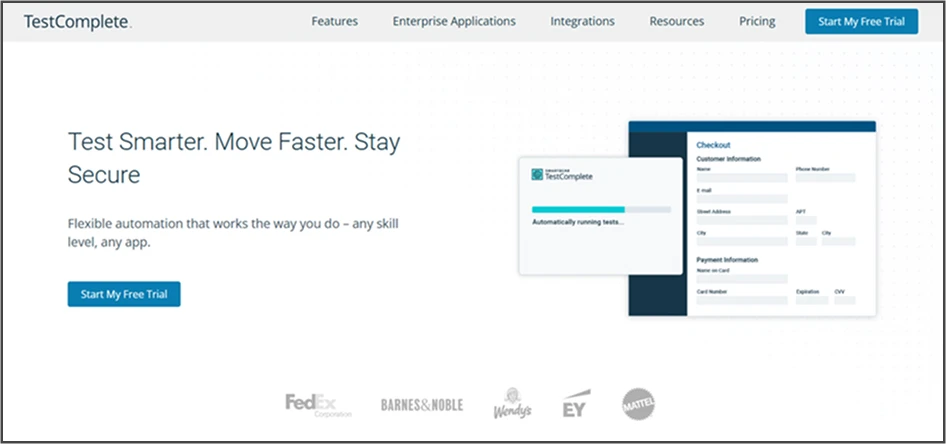
TestComplete is a commercial automated testing tool that supports web, desktop, and mobile application testing. It features an easy-to-use interface, supporting both script-based and scriptless test creation. It’s designed to streamline testing for various types of applications, making it suitable for large enterprises.
Ideal For:
- Enterprises looking for a comprehensive test automation solution across web, mobile, and desktop applications.
- Teams that need a user-friendly interface with advanced functionality and support for multiple scripting languages.
Pros:
- A complete solution for testing across different platforms.
- Includes a record-and-playback feature for users who don’t want to write scripts.
- Supports JavaScript, Python, VBScript, and more.
Cons:
- Can be cost-prohibitive for smaller businesses.
- Not open-source, so it requires a paid license.
Pricing:
- Starts at $1,829 for a single-user license
Cypress
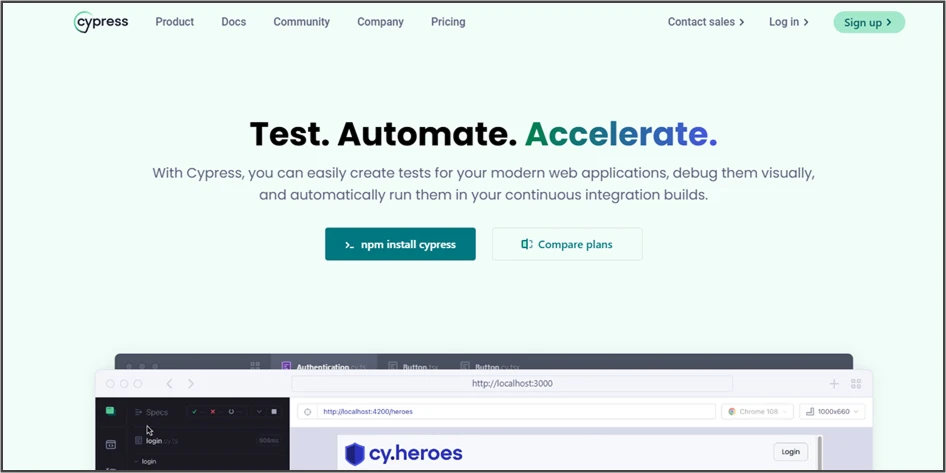
Cypress is a fast, JavaScript-based testing framework designed for end-to-end testing of web applications. It is built specifically for developers and QA teams using modern JavaScript frameworks, providing real-time testing and debugging capabilities directly in the browser.
Ideal For:
- Developers who need a fast and reliable testing solution for modern JavaScript-based web apps.
- Teams focused on web application testing, particularly those using frameworks like React, Angular, or Vue.js.
Pros:
- Offers quick feedback with real-time browser testing.
- Provides interactive tools to debug tests as they run.
- Ideal for teams that integrate their testing process with continuous integration.
Cons:
- Primarily built for JavaScript-based frameworks.
- Limited to web applications only.
Pricing:
- Free (open-source), with paid plans for enterprise features.
WebLoad

WebLoad is a commercial performance testing tool designed specifically for large-scale web applications. It is highly effective in simulating real-world traffic conditions to evaluate the performance of applications under varying levels of load. WebLoad provides powerful load testing capabilities, making it an excellent choice for businesses looking to optimize their applications for high user volumes.
Ideal For:
- Teams focusing on performance and load testing for large web applications.
- Projects with a large user base that require performance optimization, ensuring the application can handle high traffic without issues.
Pros:
- Simulates real-world traffic, helping teams assess how their apps perform under different conditions.
- Tailored for web applications that need to perform under heavy loads.
- Provides in-depth reports on application performance during testing.
Cons:
- It might be challenging for those new to load testing tools to get started.
- The pricing can be prohibitive for smaller organizations or teams with limited budgets.
Pricing:
- Custom pricing based on requirements.
LambdaTest
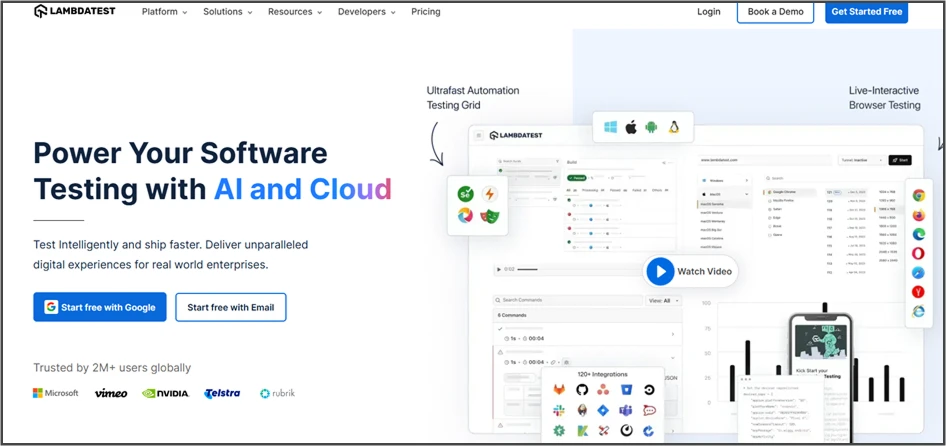
LambdaTest is a cloud-based cross-browser testing platform that allows teams to run automated and manual tests across different browser and OS combinations. It supports Selenium and Cypress scripts, making it versatile for developers and testers who rely on these frameworks for automated browser testing.
Ideal For:
- Teams requiring cross-browser testing without the need for complex infrastructure setups.
- Enterprises looking for scalable, cloud-based testing solutions that can handle a wide variety of environments.
Pros:
- No need to maintain physical infrastructure for browser testing.
- Teams can choose between writing scripts or manually testing.
- Pricing is adjusted based on team size and usage.
Cons:
- Mobile testing capabilities are not as robust as some specialized tools like Appium.
- The cost can increase significantly for larger teams or more extensive testing needs.
Pricing:
- Starts at $15/month for basic plans.
- Custom pricing for enterprise users.
Perfecto
Perfecto is a cloud-based test automation platform that focuses on providing testing solutions for both web and mobile applications. It supports both manual and automated testing and is known for its real-device testing capabilities, making it a strong choice for teams needing comprehensive testing across different platforms.
Ideal For:
- Teams needing end-to-end testing for web and mobile apps, ensuring functionality across both platforms.
- Enterprises looking for an all-encompassing mobile app testing solution, especially for real-device testing.
Pros:
- Access to real mobile and web environments for testing.
- A unified platform for all application types.
- Ideal for teams working in agile environments with continuous integration.
Cons:
- The pricing can be steep for smaller organizations.
- The platform can be harder to set up compared to simpler alternatives.
Pricing:
- Custom pricing based on requirements.
Postman
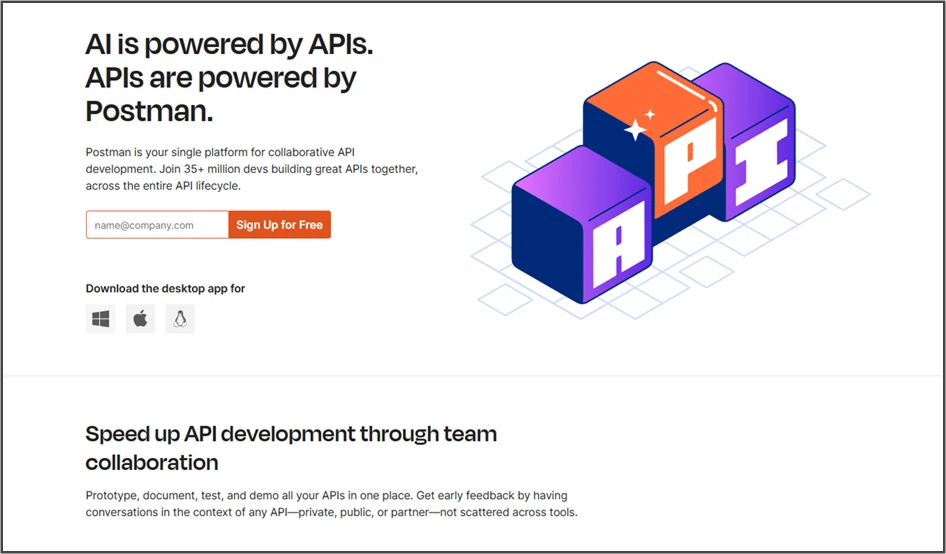
Postman is one of the most popular tools for API testing, allowing users to design, test, and document APIs efficiently. With support for REST, SOAP, and GraphQL APIs, Postman is a powerful tool that simplifies API reliability, security, and performance testing for developers and QA engineers.
Ideal For:
- Teams focusing on API testing and integration.
- Developers and QA engineers testing REST, SOAP, and GraphQL APIs to ensure reliable, secure, and efficient interactions.
Pros:
- Postman is easy to use, even for those new to API testing, yet provides powerful features.
- Enables automated API testing and smooth integration into continuous integration systems.
- Ideal for teams that need to document APIs and collaborate with others on testing.
Cons:
- Not as suitable for load or performance testing of APIs.
- As the number of tests grows, managing them within Postman can become less efficient.
Pricing:
- Basic functionality for small teams (free).
- Starting at $14 per user/month for advanced features.
Apache JMeter
Apache JMeter is an open-source tool for performance testing, widely used to test the performance of both static and dynamic resources, including web applications and databases. It supports a variety of protocols and offers powerful analysis tools for detailed reporting.
Ideal For:
- Teams focused on performance and load testing for large-scale applications.
- Testers looking for an open-source, customizable testing tool that can be adapted to various testing needs.
Pros:
- Free to use and highly customizable.
- Includes HTTP, FTP, JDBC, and more, allowing you to test a variety of resources.
- Offers in-depth insights into application performance.
Cons:
- New users might find it difficult to get started due to its complexity.
- The user interface can feel outdated compared to other tools.
Pricing:
- Free and open-source.
SoapUI
SoapUI is an open-source tool specifically designed for testing web services, especially SOAP-based services, though it also supports REST APIs. It is a widely used tool for functional and performance testing of APIs, particularly for those in enterprise environments.
Ideal For:
- Teams focused on SOAP and REST API testing.
- Projects requiring integration and service-level testing to ensure the reliability and performance of API-based services.
Pros:
- Ideal for teams testing a range of web services.
- Provides powerful features for simulating and testing web service behavior.
- Makes it easy to analyze test results and simulate services.
Cons:
- Limited functionality for other types of testing, such as UI or performance.
- The design can feel less modern compared to other testing tools.
Pricing:
- Free plans are available with limited functionality.
- Paid plans are available with more advanced features.
Tricentis Tosca
Tricentis Tosca is an enterprise-level test automation platform designed to deliver comprehensive testing solutions for both functional and non-functional testing needs, such as load, security, and performance testing.
Ideal For:
- Large organizations with complex testing requirements
- Teams utilizing risk-based testing methodologies and test automation for critical applications
Pros:
- Strong test management and automation capabilities
- Seamless integration with CI/CD pipelines and DevOps workflows
- Advanced risk-based testing ensures that the most critical parts of the application are thoroughly tested
Cons:
- Can be expensive for smaller teams or startups
- Requires a complex setup with a steep learning curve
Pricing:
Custom pricing based on the organization’s specific needs
TestSigma
TestSigma is a cloud-based test management and automation platform specifically designed to cater to Agile and DevOps teams. It provides a unified platform for both manual and automated testing, with seamless integration across a variety of tools.
Ideal For:
- Agile teams looking for a user-friendly test management and automation tool
- Teams needing seamless integration for end-to-end test management
Pros:
- Simple and intuitive interface
- Strong integrations with CI/CD tools like Jira, GitHub, and Slack
- Supports both manual and automated testing with detailed analytics
Cons:
- Lacks some advanced features found in larger test automation suites
- Performance testing features are not as robust as other specialized tools
Pricing:
Paid pricing
Applitools
Applitools is a visual testing and monitoring platform that leverages AI to detect visual discrepancies across web and mobile applications. It ensures a consistent user experience by enabling teams to perform cross-browser and cross-device visual testing.
Ideal For:
- Teams focused on UI/UX testing for web and mobile apps
- Developers and QA engineers performing visual testing across multiple browsers and devices
Pros:
- Powerful visual AI capabilities to detect UI issues
- Supports cross-browser and cross-device testing
- Integrates well with popular testing frameworks such as Selenium, Cypress, and Appium
Cons:
- Can be expensive, especially for teams with large-scale testing needs
- AI-driven testing may occasionally result in false positives or negatives without fine-tuning
Pricing:
Custom pricing based on team size and feature requirements
Robot Framework
Robot Framework is an open-source automation testing framework that uses a keyword-driven approach for testing web, mobile, and desktop applications. It’s well-suited for acceptance testing and robotic process automation (RPA), and it allows non-developers to automate tests easily.
Ideal For:
- Teams looking for a flexible and simple framework for test automation
- Non-developers who want to automate testing through keyword-driven syntax
Pros:
- Open-source and highly customizable
- Supports multiple platforms, including web, mobile, and desktop
- Extensible with a wide range of libraries and tools
Cons:
- Requires some setup and knowledge of keyword-driven testing
- Lacks some of the advanced features available in more modern, paid tools
Pricing:
Free and open-source
Eggplant Functional
Eggplant Functional is a comprehensive test automation tool known for its functional testing capabilities. It offers cross-platform support for web, mobile, and desktop applications, leveraging AI-driven testing and image-based recognition for automated test execution.
Ideal For:
- Teams that require functional testing across various platforms
- Enterprises focused on automating end-to-end testing
Pros:
- Cross-platform support for web, mobile, and desktop applications
- High level of customization and flexibility
- Integrated with CI/CD pipelines for continuous testing
Cons:
- High learning curve for new users
- Expensive for smaller teams
Pricing:
Custom pricing based on team size and needs
Mabl
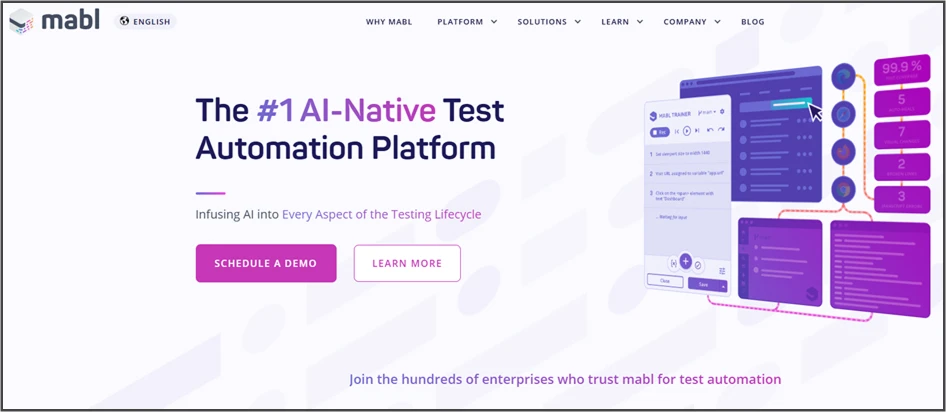
Mabl is a cloud-based test automation platform designed for modern web applications. It utilizes AI and machine learning to create and maintain automated tests with minimal setup, making it a great solution for teams focused on Agile development.
Ideal For:
- Teams seeking a fully automated testing solution with minimal manual intervention
- Agile teams looking for seamless CI/CD integration
Pros:
- Easy-to-use interface with minimal coding required
- Seamlessly integrates with CI/CD pipelines
- Automatically adapts to UI changes, reducing maintenance work
Cons:
- Limited support for non-web-based testing
- Pricing may be prohibitive for larger teams
Pricing:
Request quote
LoadRunner
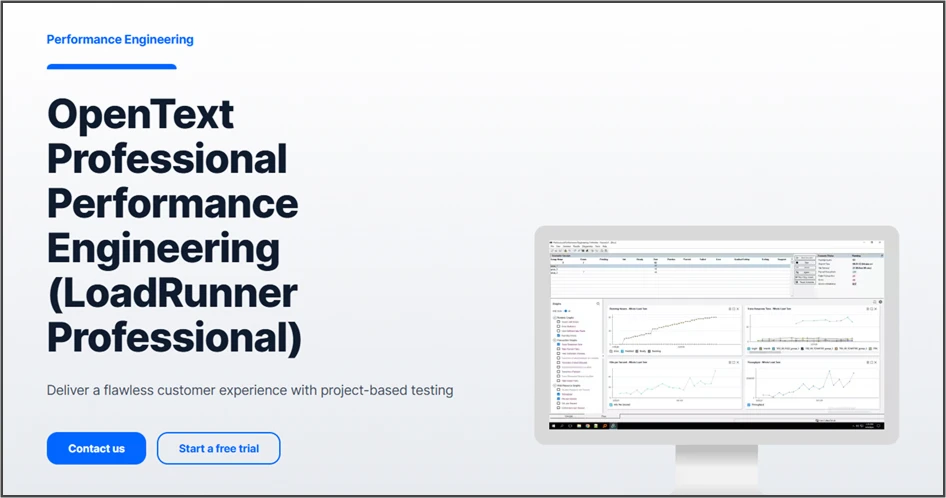
LoadRunner is a robust performance testing tool designed to simulate a large number of users to evaluate the scalability of web and enterprise applications. It supports a wide range of protocols and environments, making it ideal for teams focused on performance and load testing at scale.
Ideal For:
- Teams focused on performance and load testing for large-scale web and enterprise applications
- Organizations testing the scalability of critical systems
Pros:
- Advanced load testing and performance monitoring capabilities
- Supports a wide array of protocols and environments
- Provides detailed reporting and performance analysis tools
Cons:
- Expensive, making it less suitable for smaller teams
- Can be difficult to configure and set up
Pricing:
Custom pricing based on organizational needs
Choosing the Right QA Tool for Your Needs
Selecting the right QA tool for your project is a crucial decision that can significantly impact your testing process and overall product quality. The ideal tool for your team will depend on several factors, including the type of application being tested, your team’s technical proficiency, your budget, and the scope of testing required. Here are some key points to help guide your decision-making process:
1. Assessing Your Application Type: Web, Mobile, or API
- Web Testing: If you’re testing web applications, tools like Cypress and Selenium are excellent choices. Both tools are designed to handle the complexities of web interfaces, but Cypress is particularly known for its fast execution and real-time debugging. Selenium offers flexibility, supporting multiple browsers and programming languages.
- Mobile Testing: For mobile applications, Appium is a top choice because it supports both Android and iOS, allowing teams to test across platforms with the same scripts. If you’re focused solely on Android, Espresso offers fast and reliable testing for native Android apps.
- API Testing: For API testing, tools like Postman and SoapUI stand out. Postman is a great option for REST, SOAP, and GraphQL APIs, with a user-friendly interface and integration with CI/CD pipelines. SoapUI is better suited for enterprise environments with its powerful service virtualization and support for both SOAP and REST.
2. Evaluating Your Team’s Technical Proficiency: Code-Based vs. Codeless Testing
Your team’s expertise plays a significant role in selecting the right tool.
- Code-Based Tools: If your team has solid coding skills, tools like Selenium, Appium, and Cypress (which all require scripting) will allow you to have full control over the automation process. These tools provide great flexibility but require knowledge of programming languages and frameworks.
- Codeless Tools: If your team is less technically inclined, consider codeless testing tools such as TestSigma or Tricentis Tosca. These tools offer easy-to-use interfaces that allow for automation without needing extensive coding skills, making them ideal for teams with limited programming expertise. However, they may lack the depth and flexibility offered by code-based tools.
3. Considering Budget: Premium vs. Open-Source Tools
- Open-Source Tools: If you’re working within a limited budget, open-source tools like Selenium, Apache JMeter, and Postman can help you deliver quality testing without incurring high licensing fees. Open-source tools can be customized and extended, but may require more setup and maintenance.
- Premium Tools: On the other hand, premium tools like TestComplete, Perfecto, and LoadRunner offer a wider range of features, ease of use, and better support, but they come at a cost. Consider whether the additional functionality justifies the price for your project. These tools often include better customer support and faster setup, which can save time in the long run.
4. Defining the Scope of Testing: Functional, Performance, or Security Testing
- Functional Testing: If the primary focus is on testing the core functionality of the application, tools like Cypress, Selenium, or TestComplete offer robust support for web, mobile, and desktop testing.
- Performance Testing: For applications that require performance testing, tools like WebLoad, LoadRunner, and Apache JMeter are best suited to simulate heavy traffic and identify performance bottlenecks.
- Security Testing: For security testing, you might need specialized tools like OWASP ZAP or Burp Suite, which are designed to identify security vulnerabilities and ensure the safety of your application.
5. Ensuring Integration with Existing Development Tools
A key factor in selecting a testing tool is how well it integrates with your team’s existing development and project management tools. Consider the following:
- Version Control: Tools that integrate with version control systems (e.g., GitHub, GitLab) are essential for maintaining synchronization between code changes and tests.
- CI/CD Pipelines: Your testing tool must work smoothly with your CI/CD pipelines (e.g., Jenkins, CircleCI). Tools like Selenium, Cypress, and Playwright support automated testing directly within these pipelines, allowing for continuous testing throughout the development cycle.
- Issue Tracking Systems: Make sure the tool integrates with issue-tracking systems like Jira or Trello. This ensures smooth communication between testers and developers, with bugs being logged and tracked easily.
Emerging Trends in QA Testing for 2025
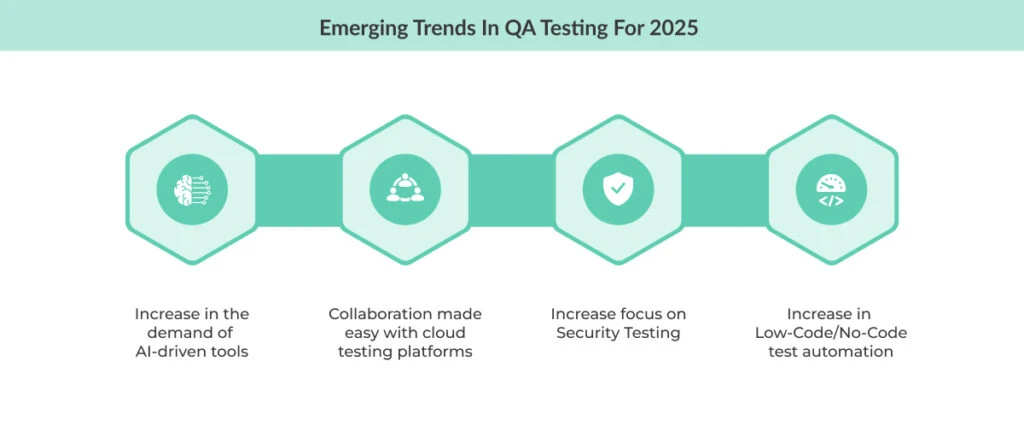 As we move into 2025, several trends are shaping the future of QA testing. These new technologies and methods are making testing faster, smarter, and more efficient. Here are the key trends to watch:
As we move into 2025, several trends are shaping the future of QA testing. These new technologies and methods are making testing faster, smarter, and more efficient. Here are the key trends to watch:
1. AI and Machine Learning in Test Automation
AI and machine learning are transforming test automation. These technologies help tools automatically generate and optimize tests, predict issues, and improve test coverage. With AI-driven tools, teams can identify patterns in test failures and get better insights, making tests more accurate and faster.
2. Cloud-Based Testing Solutions
Cloud-based testing is becoming more common because it’s scalable, flexible, and faster. Cloud testing platforms allow teams to run tests on different devices and environments without the need for physical hardware. This makes collaboration easier, reduces setup time, and speeds up the testing process. In the coming times, cloud-based testing will be standard for many teams.
3. Increased Focus on Security Testing
Security testing is more important than ever, especially as cyber threats grow. Tools are now able to detect vulnerabilities early in development, helping teams prevent security issues before they happen. As part of the DevSecOps movement, security testing will be integrated into every stage of development, ensuring apps are secure before they go live.
4. Low-Code/No-Code Test Automation
Low-code and no-code tools are making test automation accessible to non-technical users. These tools allow anyone on the team to create and run automated tests without coding skills. In 2025, we will see even more powerful low-code/no-code tools, allowing QA teams to scale their automation efforts and work faster.
Conclusion
Selecting the right QA testing tool depends on the needs of your project, the complexity of your applications, and your team’s technical skills. Whether you’re looking for performance testing, functional automation, API testing, or visual checks, there’s a tool on this list that can help streamline your testing efforts and improve software quality.
QA Touch is an efficient test management platform that simplifies the test management process for Agile teams by offering an easy-to-use interface and strong integration capabilities with existing CI/CD pipelines. It allows teams to maintain better test coverage, track issues effectively, and generate insightful reports, making it an ideal tool for both manual and automated testing in fast-paced development environments.
Sign up today. It is free till you upgrade.



